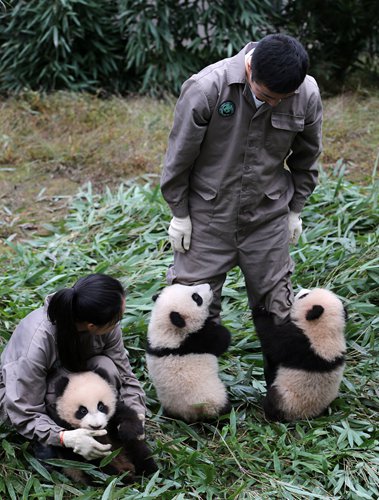
From the People’s Daily app.
This is Story in the Story.
Though giant pandas are no longer technically endangered following China's extensive conservation efforts, the bears still face an uncertain future, namely whether or not they can return to the wild rather than stay captive.
Pandas were downgraded from "Endangered" to "Vulnerable" by the International Union for Conservation of Nature (IUCN) after a nationwide census in 2016 discovered 1,864 pandas living in the wild in China, a 16.8 percent increase since the 2003 survey.
While more and more people, through live-streaming, are getting to know pandas as cute, captive-bred animals, wild pandas and rangers of their habitat are often neglected. Experts say the ultimate goal is to release captive-bred pandas into the wild, but how to carry out that goal remains a big question.
Since Soong May-ling, wife of Chiang Kai-shek, gifted a pair of giant pandas to the US on behalf of the government of the Republic of China (1912-49) in 1941, pandas have become China's most famous diplomatic gift.
After the founding of the People's Republic of China, 24 pandas were given to nine foreign countries as goodwill gestures. The most famous of these gifts were probably Ling-Ling and Hsing-Hsing, two giant pandas given to the US as gifts after President Richard Nixon visited China in 1972.
In 1982, the government began to loan pandas to zoos around the world. By 1988, at least 30 American zoos and other international organizations were applying for panda loans. All these pandas were captured in the wild.
China started training giant pandas to live in the wild in 2003. The goal is to release them into their natural habitat to boost the wild population. Programs to re-introduce and integrate pandas into the wild have, however, proved to be quite difficult.
Forestry authorities in China's northwestern Shaanxi Province have recently launched an ecological corridor program that is designed to connect fragmented habitats of giant pandas to promote the gene flow between the wild population.
Today's Story in the Story will look at how reintegrating giant pandas into natural habitat remains a tough challenge.

Panda cubs bear-hug their keepers at China Conservation and Research Center for Giant Panda in Ya'an, Sichuan Province. (Photo: VCG)
A video uploaded by ipanda.com last February showing a panda named Qiyi chasing his keeper for a hug was viewed over 50 million times on Weibo and 120 million times on Facebook.
These pandas are the second- and third- generation that grew up in captivity since the Wolong National Nature Reserve started to breed pandas in the 1980s. Nationwide, the practice started even earlier, in the 1950s.
Hu Zhichu, an 89-year-old expert on giant pandas, said captive breeding was not intended to sustain the panda population, but only to meet the growing international curiosity and demand for the animal.
The practice of keeping pandas in captivity, however, resulted in an immediate decline in the overall number of wild giant pandas. In Baoxing county, for example, over 300 pandas were recorded during the first panda census in the early 1970s. Now there are only 100.
"This is because, since the 1950s, 136 wild pandas have been held captive in Baoxing county, and most of them are cubs, which are easy to capture," Hu said.
Until 1999, records from the Panda Studbook reveal that only 66 adult pandas (28 percent) in captivity are breeding and only 12 have been born in captivity.
Of all captive-born males, only two are reported to have ever mated and only 12 percent of captive-born pandas survive the first year. Newborn pandas often die at an early age; in order to maintain the captive population, new wild pandas had to be captured.
Since 2000, due to breakthroughs in artificial insemination and cub rearing, the number of captive-bred pandas started to rise.
But captive breeding has many side effects. Under captive conditions, the animals' lack of enthusiasm about mating is exacerbated. Breeders have also tried a number of measures to try to boost the sex drive of male pandas.
Pandas in Beijing Zoo, for example, lost their breeding capabilities and had to be shipped to Sichuan to be artificially inseminated. "Although captive-bred pandas resemble wild ones, they are actually quite different," Hu said.

Panda cubs in captivity meet with visitors. (Photo: VCG)
Close breeding is another issue threatening the health of pandas in captivity. More than a quarter of the world's captive-bred panda population descended from the same male giant panda, Panpan, who was thought to have over 130 descendants.
Panpan died in December 28, 2016, as the oldest male giant panda in captivity, he nevertheless exacerbates close breeding among pandas.
At Dengsheng Protection Station in Wolong National Nature Reserve, the highest protection station in Wolong with an altitude of 2,700 meters, 19 employees are in charge of patrolling and researching 80,000 hectares of mountains, valleys and rivers. Those who patrol the mountains receive a subsidy of 120 yuan ($19) per day, which many workers complain is too low.
Prior to 2008, the station had no access to electricity and workers had to make fire for warmth at night. Following the Wenchuan earthquake, workers at the station lived in makeshift shipping containers donated to them through charity programs.
In recent years, after the Hong Kong government sponsored construction at the station, the employees finally had a place to live with stable electricity and internet.
Having worked at Wolong for 30 years, Yang Jian, head of the Dengsheng Protection Station, said he has seen wild pandas only three times in his career. Real wild pandas, unlike captive ones, hide from humans once they smell their arrival; spotting one in the wilderness is a rare treat.
Even though wild pandas are difficult to find, workers must pay attention to every detail in the animal's habitat while also preventing illegal poaching, tree-cutting, herb-collecting and fire hazards.
These employees are also the heroes behind research projects like China's national panda census. In order to complete the census, workers at the station divide the area into dozens of grids, then search for and pick up panda feces in each grid, often enduring extreme climate conditions.
Xiang Xiang, which translates as "Auspicious," was selected for training at the age of 2. It was released back into its natural habitat at Wolong Nature Reserve for Giant Pandas in 2006 but was found dead in February of the following year.
"Living in the wild and in an artificial environment are each very different. In terms of food, wild pandas eat bamboo shoots in the spring, bamboo in the summer and bamboo leaves in the autumn. In an artificial environment, they can eat whatever they want. Such eating habits are hard to change," Hu said.
Hu said the most ideal method would be to ask an animal expert to train pandas in the wild, but it is difficult to put it in practice. A more practical way is to place a captive female panda in a half-wild environment and attract a wild male panda to mate with her. This will introduce wild panda genes; their offspring may turn out to be more accustomed to life in the wild. But how it turns out will depend on future experiments.
(Produced by Nancy Yan Xu, Terry Guanlin Li, Raymond Mendoza and Lance Crayon. Music by: bensound.com. Text from Global Times and People’s Daily.)


